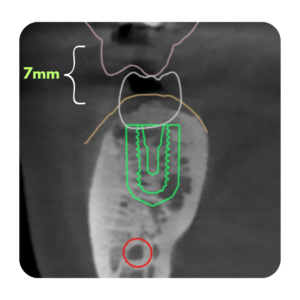If you’re like most dentists, you’d like to implement evidenced-based dental techniques in your practice, but don’t have any time to go searching through and comparing various articles on Pubmed. Well, I am a bit of a nerd and research is one of my pastimes –so I’ll give you the quick rundown of some articles I’ve studied on Insertion Torque (IT) during dental implant placement.
In my practice I’ve been placing lots of dental implants and I am pretty comfortable that I know what I’m doing. The final torque values that I get are about 30-60 Ncm and I’ve always thought that a higher insertion torque was better than a lower one. But one of my friends went to the Academy of Osseointegration (AO) meeting last year and told me that they discussed why a lower torque (25Ncm) might be better!
Of course, I was concerned. Does this mean that my 60Ncm implants are going to fail?? (I am overreacting for dramatic effect) What should I use for my surgeries? High or Low torque?
[mepr-show if=”loggedout”] Login or signup to Implant Ninja Dojo to read the rest of this article.[/mepr-show]
[mepr-show if=”loggedin”]I quickly put together a list of articles and scoured them for them for answers. Here is a summary of my findings, along with a list of all the references at the bottom. If for some reason (maybe you’re a nerd too) you want my full length summary of all the findings, just message me. I’m happy to give it to you.
So my first priority is to avoid implant failure. Ottani shows us that low insertion torques can be associated with failure, while Rizkallah and Khuyat used high insertion torques (often exceeding 100 Ncm) with very high success rates. Furthermore, Trisi shows us that higher torque provides higher stability over the healing period and that microcracks produced by high torque surgeries can accelerate bone remodeling.
So let’s set a minimum torque value for ourselves. Ottani helps us by suggesting that the minimum be around 32 Ncm–he saw several failures with torques below this value. While Norton had great success with low torques (under 25 Ncm), others have run into problems so I am not convinced that I am going to implement this at my office. I’m going to set my minimum at 30 Ncm.
I know from my surgical experience that sometimes I don’t always reach the torque value that I want–I want to avoid the dreaded “spinning implant.” So in order to have my lowest bound be 30 Ncm, I will not aim for any lower than 40 Ncm. This reduces the risk of getting a torque value that is too low.
Aside from preventing failure, I also want to optimize the bone health around my implant and I want to maintain marginal bone levels. Cha et al postulates that high IT causes more bone necrosis and that the higher bone strains can cause bone resorption–so I am cautious to not go to crazy with a high torque value. Perhaps the best thing to do is shoot for a torque value that is safely above the 30 Ncm minimum that I set for myself.
Can I do this while maintaining good marginal bone levels? Well, according to a study by Valentini, this is possible. By placing and immediately loading implants with an insertion torque of at least 40 Ncm, he was able to have a high success rate (95.3%) and maintain optimum bone levels similar to Norton. I’m going to follow his lead and place my target insertion torque to 40 Ncm.
Of course, you can achieve successful clinical outcomes with a variety of strategies. It is important to choose the strategy that you are most comfortable with and that is soundly supported by the literature.
Thank you for reading.
Best,
Ivan
References:
J.Y. Cha. Multiscale Analyses of the Bone-Implant Interface. Journal of Dental Research. 2015. Vol 94(3) 482-490.
Rizkallah, N et al. Correlation Between Insertion Torque and Survival rates in Immediately Loaded Implants in the Maxilla: A Retrospective Study. Implant Dentistry Vol 22 Number 3, 2013.
Khayat, P. Clinical Outcome of Dental Implants Placed with High Insertion Torques. Clinical Implant Dentistry and Related Research. 2011.
Trisi P et al. High Versus Low Implant Insertion Torque: A Histologic, Histomorphometric, and Biomechanical Study in the Sheep Mandible. The International Journal of Oral and Maxillofacial Implants. 2011.
Norton M. The Influence of Insertion Torque on the survival of Immediately Placed and restored Single Tooth implants.
Ottoni, J. Correlation Between Placement Torque and Survival of Single Tooth Implants. International Journal of – Oral and Maxillofacial Implants.
Vallentini, P et al. Immediate Provisonalization of Single Extraction-Site implants in the esthetic Zone. The International Journal of Periodontics & Restorative Dentistry. Vol 30 Number 1, 2010.[/mepr-show]




Responses